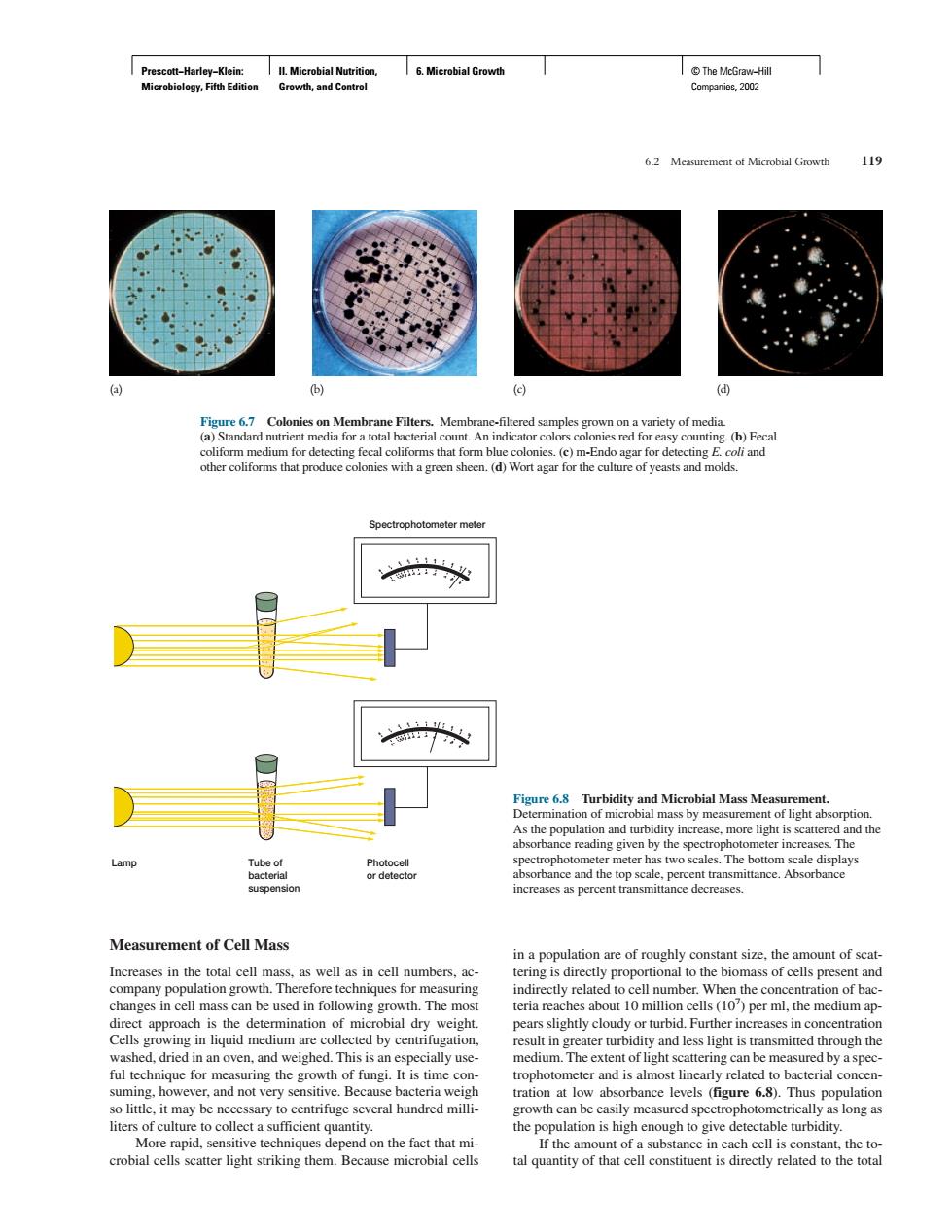正在加载图片...

6.Microbial Growh 119 Figure 6.7 Colonie variety of media Measurement of Cell Mass in a population are of roughly constant size.the amount of scat teria r about cells(1)per ml,the mediumap slightly clou centr d,dried in an oven,and weighed.This is an especially use so little,it may be necessary several hundred milli- growth can be e the puthe am crobial cells scatter light striking them.Because microbial cells tal quantity of that cell constituent is directly related to the total Prescott−Harley−Klein: Microbiology, Fifth Edition II. Microbial Nutrition, Growth, and Control 6. Microbial Growth © The McGraw−Hill Companies, 2002 Measurement of Cell Mass Increases in the total cell mass, as well as in cell numbers, accompany population growth. Therefore techniques for measuring changes in cell mass can be used in following growth. The most direct approach is the determination of microbial dry weight. Cells growing in liquid medium are collected by centrifugation, washed, dried in an oven, and weighed. This is an especially useful technique for measuring the growth of fungi. It is time consuming, however, and not very sensitive. Because bacteria weigh so little, it may be necessary to centrifuge several hundred milliliters of culture to collect a sufficient quantity. More rapid, sensitive techniques depend on the fact that microbial cells scatter light striking them. Because microbial cells in a population are of roughly constant size, the amount of scattering is directly proportional to the biomass of cells present and indirectly related to cell number. When the concentration of bacteria reaches about 10 million cells (107 ) per ml, the medium appears slightly cloudy or turbid. Further increases in concentration result in greater turbidity and less light is transmitted through the medium. The extent of light scattering can be measured by a spectrophotometer and is almost linearly related to bacterial concentration at low absorbance levels (figure 6.8). Thus population growth can be easily measured spectrophotometrically as long as the population is high enough to give detectable turbidity. If the amount of a substance in each cell is constant, the total quantity of that cell constituent is directly related to the total 6.2 Measurement of Microbial Growth 119 Figure 6.7 Colonies on Membrane Filters. Membrane-filtered samples grown on a variety of media. (a) Standard nutrient media for a total bacterial count. An indicator colors colonies red for easy counting. (b) Fecal coliform medium for detecting fecal coliforms that form blue colonies. (c) m-Endo agar for detecting E. coli and other coliforms that produce colonies with a green sheen. (d) Wort agar for the culture of yeasts and molds. (a) (b) (c) (d) Spectrophotometer meter Photocell or detector Tube of bacterial suspension Lamp 10 9 8 7 4 5 6 3 2 1 0 0 .0 .1 .6 .5 .4 .3 .2 .8 .7 1.9 1. 10 9 8 7 4 5 6 3 2 1 0 0 .0 .1 .6 .5 .4 .3 .2 .8 .7 1.9 1. Figure 6.8 Turbidity and Microbial Mass Measurement. Determination of microbial mass by measurement of light absorption. As the population and turbidity increase, more light is scattered and the absorbance reading given by the spectrophotometer increases. The spectrophotometer meter has two scales. The bottom scale displays absorbance and the top scale, percent transmittance. Absorbance increases as percent transmittance decreases